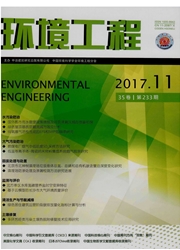

 中文摘要:
中文摘要:
应用包埋固定化微生物处理垃圾渗滤液,确定适宜的进水浓度和水力停留时间(HRT),采用GC-MS分析渗滤液有机污染物的降解特性,并鉴定优势菌种,为应用固定化微生物提高渗滤液生化处理效率提供依据。结果表明:当进水ρ(COD)为700~800 mg/L,ρ(NH3-N)为300~400 mg/L时,固定化微生物对渗滤液的处理效果最好,此时最佳HRT为72 h,COD去除率达39.0%,氨氮去除率达69.0%;有机物组分分析显示固定化微生物对渗滤液中的烷烃类和羧酸类有较强的去除效果;菌种鉴定表明反应池中的主要优势菌种有鲁氏不动杆菌(Acinetobacter lwoffii),少动鞘氨醇单胞菌(Sphingomonas paucimobilis),嗜麦芽寡养单胞菌(Stenotrophomonas maltophilia),洋葱伯克霍尔德菌群(Burkholderia cepacia group),代尔夫特食酸菌(Delftia acidovorans),泛菌属(Pantoea sp)等6种具有降解有机物和脱氮能力的细菌。
 英文摘要:
英文摘要:
Embedded immobilized microorganism was applied for the landfill leachate treatment. The paper investigated feasible influent concentration and hydraulic retention time( HRT) by model experiment,and analyzed the degradation characteristics of the organic pollutants in leachate by GC-MS,as well as identified dominant bacteria,that provides a basis for improving biochemical treatment effect of leachate by immobilized microorganism technology. The results showed that when the influent COD and ammonia were 700 ~ 800 mg/L and 300 ~ 400 mg/L,respectively,the treatment effect was best,the optimal HRT was 72 h at the moment,the COD and ammonia removal rate arrived at 39. 0% and 69. 0%,respectively.Organic pollutants analysis revealed that the well removal efficiency of alkanes and carboxylic acids in leachate was achieved by immobilized microorganism. Strains identification demonstrated that there were six dominant strains with strong organic pollutants degradation and denitrification ability in the reactor,which was identified as Acinetobacter lwoffii,Sphingomonas paucimobilis,Stenotrophomonas maltophilia,Burkholderia cepacia group,Delftia acidovorans and Pantoea sp.
 同期刊论文项目
同期刊论文项目
 同项目期刊论文
同项目期刊论文
 期刊信息
期刊信息
